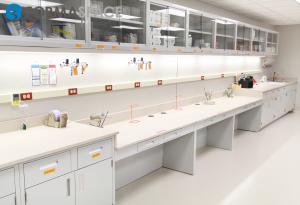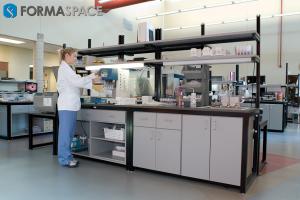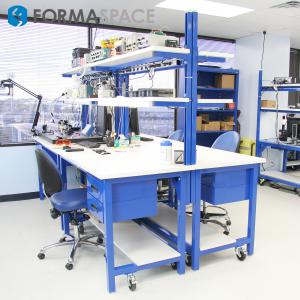vWhat are the Do’s and Don’ts for Wet Lab & Dry Lab Users
Keep safety & flexibility in mind when planning a new Wet Lab or Dry Lab build out. Read these Do’s and Don’ts.
Consider These Laboratory Safety Guidelines as Part of Your Good Laboratory Practices (GLP)”
AUSTIN, TEXAS, UNITED STATES, March 2, 2017 /EINPresswire.com/ -- Advances in laboratory research keep accelerating with new techniques and technologies changing the way laboratory researchers perform experiments and make discoveries. These changes have made it more important than ever for lab architects and lab managers to keep flexibility in mind when planning new laboratory construction or renovations.— Formaspace
Major advances in the capabilities of scientific lab equipment, digital computing, and experimental research methods and techniques have had a significant impact on the physical design, layout, and safety considerations for lab safety and design. As a result, modern laboratory design has to be flexible and functional to keep up.
This applies to both of the two traditional lab design categories: Wet Labs and Dry Labs.
Wet Lab Design Considerations
Even though scientific equipment has advanced, the importance of wet labs has not fundamentally changed. These types of labs handle a range of biological specimens, chemicals, drugs, and other materials for use in experiments. In order to support scientific research effectively and safely, wet labs need a range of tools, equipment, and services at hand, such as:
- Lab bench countertops and sinks which can be cleaned easily and are resistant to bacteria and chemicals
- Piped in hot and cold water, often including reverse osmosis (RO) or deionized water
- Chemical fume hoods and biosafety cabinets (BSCs)
- Facilities for handling live test specimens (animal housing aka vivariums) or proximity to clinics for human subjects
- Specialized refrigerators and freezers for storing tissue and other specimens
- Controlled environment areas (warm or cold rooms)
- Autoclaves and other sterilization equipment
- Glass washing and drying area
- Piped in compressed air and vacuum as well as a range of other gasses like natural gas, oxygen, etc.
- Radioactive work area for radiological materials, including safe storage facilities
- Safety showers, eye wash stations, and hand washing stations
- Climate control of ambient air and ventilation (HVAC)
- Vibration controls for sensitive experiments, such as DNA sequencing.
- Drain, Waste, and Vent (DWV) services
Dry Lab Design Considerations
As computers and digital instruments have become more and more central to scientific research, the role of most dry labs has expanded from providing a space for working with dry stored chemicals to a lab space populated with a network of powerful computing systems. There is a light-hearted description for this shift toward computer-based research: while wet labs (working with chemicals and live specimens) make discoveries in vitro, the dry lab discoveries are made in silica using computer software.
Dry laboratory spaces will have fewer requirements for piped services than wet labs. But that doesn’t mean they don’t have their own unique requirements. Increasingly, dry labs need these types of services:
- Extensive cooling and humidity controls to support computer labs (HVAC)
- Clean power systems for sensitive computers, research instruments, and network communications
- Occassional clean room system installations are required for certain processes and experiments
- Vibration controls for sensitive instruments that need to maintain calibration
- Fire suppression systems
What Kinds of Scientific Activities Take Place in Modern Research Laboratories?
To help visualize the different types of activities taking place in wet labs versus dry labs, here is a breakdown of the different types of activities taking place in each one:
Wet Lab Examples
Biomedical Laboratories
- Anaerobic Chamber Labs
- Cell Biology Labs
- Fermenter Labs
- Molecular Biology Labs
- Pathology Labs
- Tissue Culture Labs
Chemistry Laboratories
- Organic Chemistry Labs
- Physical Chemistry Labs
Dry Lab Examples
(Note: samples for study are often prepared in adjacent wet labs)
Instrument and Special Function Labs
- Computer Labs (Mainframe, Workstation, and PCs)
- Confocal Microscope Labs
- Electromagnetic Instrument Labs
- Electron Microscope (EM) Labs
- Electrophysiology and Biophysics Labs
- Flow Cytometry Labs
- Laser Labs
- Mass Spectrophotometry (MS) Labs
- Robotic Equipment Labs
- X-Ray Crystallography Labs
Do’s and Don’ts of Good Laboratory Design Planning
1. Do Remain Flexible
Given the rate of change in laboratory technology and the rapid expanse into new areas of scientific research, it’s critical to maintain flexibility in your choice of furniture. Modular furniture allows you to re-configure your laboratory layout easily to accommodate new usages.
2. Don’t Rely on Fixed Casework Alone
Read more... https://formaspace.com/articles/laboratory-furniture/dos-donts-wet-lab-dry-lab-users/?utm_source=einpresswire&utm_medium=content&utm_campaign=article-081716
Mehmet Atesoglu
Formaspace
8002511505
email us here
Legal Disclaimer:
EIN Presswire provides this news content "as is" without warranty of any kind. We do not accept any responsibility or liability for the accuracy, content, images, videos, licenses, completeness, legality, or reliability of the information contained in this article. If you have any complaints or copyright issues related to this article, kindly contact the author above.



